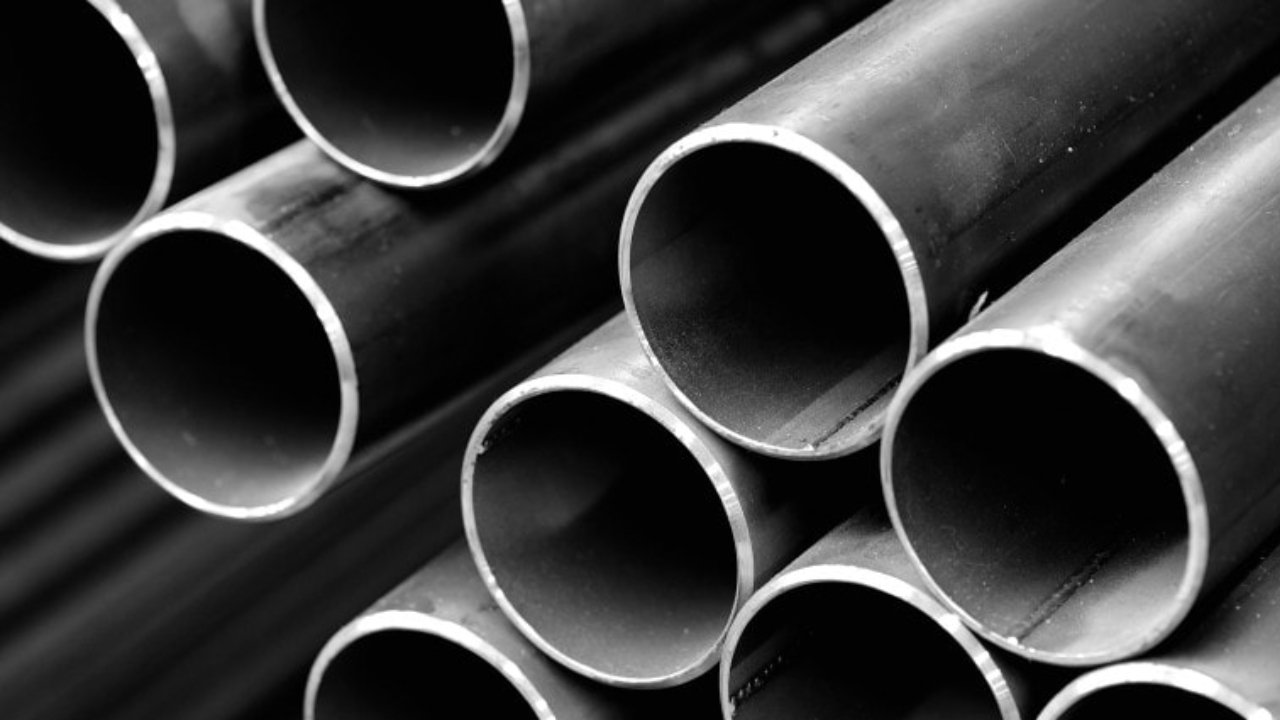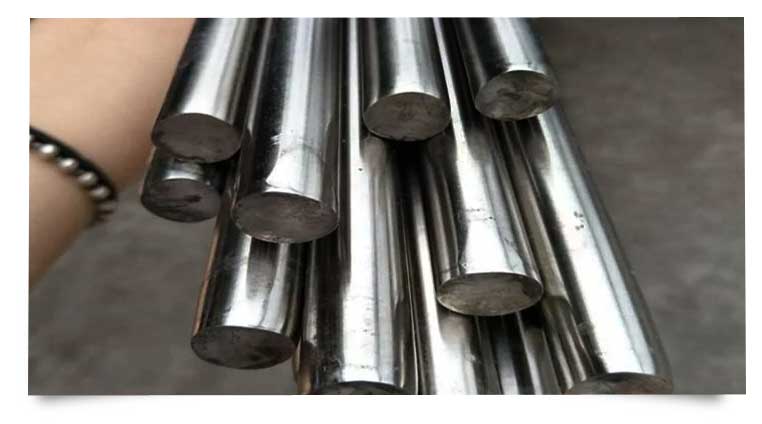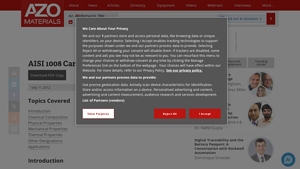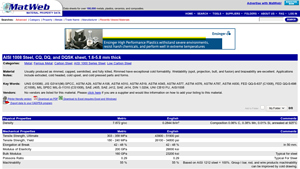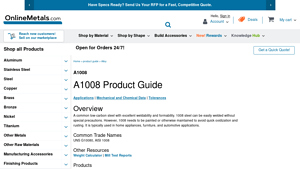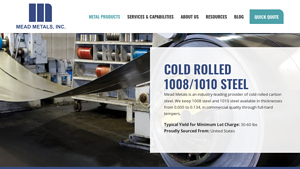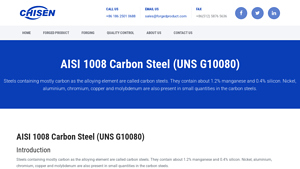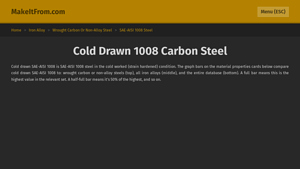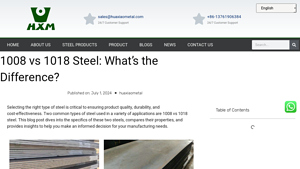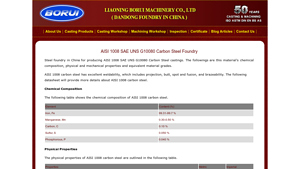1008 Steel Properties Guide: Type, Cost, Top List…
Introduction: Navigating the Global Market for 1008 steel properties
As international B2B buyers grapple with the complexities of sourcing optimal materials, understanding the properties of 1008 steel becomes crucial. This versatile low-carbon steel is known for its excellent weldability and formability, making it a common choice in diverse applications such as automotive, furniture, and home appliances. However, poor maintenance can lead to rapid oxidation, presenting a challenge for companies aiming for durability and cost-effectiveness in their production processes.
This comprehensive guide delves deep into the properties of 1008 steel, examining its mechanical characteristics, types, and industry applications. Buyers will find invaluable information on effectively vetting suppliers, assessing cost variables, and understanding the nuances of different steel grades and tempers. With insights tailored specifically for buyers from Africa, South America, the Middle East, and Europe—including regions like Vietnam and Nigeria—this guide aims to empower informed purchasing decisions.
By offering a detailed exploration of 1008 steel properties, this resource equips decision-makers with the knowledge to choose the right materials that align with their operational needs and financial objectives. Understanding these fundamental aspects is critical in navigating the global market, ensuring that your business remains competitive while optimizing product quality and efficiency.
Understanding 1008 steel properties Types and Variations
| Type Name | Key Distinguishing Features | Primary B2B Applications | Brief Pros & Cons for Buyers |
|---|---|---|---|
| Cold Rolled 1008 | High strength, tighter tolerances, smoother surface finish | Automotive body parts, furniture, appliances | Pros: Excellent formability and machining; ideal for precise applications. Cons: Susceptible to oxidation, requiring protective coatings. |
| Hot Rolled 1008 | Less expensive, thicker material options | Construction, manufacturing, heavy machinery | Pros: Cost-effective for bulk applications. Cons: Rougher surface finish and lower strength compared to cold rolled variants. |
| 1008 Deep Drawing Steel | Enhanced ductility for complex shapes | Automotive components, packaging | Pros: Allows for intricate designs with minimal cracking. Cons: Requires skilled processing to optimize performance, risking increased costs. |
| 1008 Steel for Machining | Optimal machinability with consistent quality | Tools, dies, precision components | Pros: Good balance of strength and machinability, supports various finishing processes. Cons: Can be more expensive than less refined grades. |
| Alloy Variants of 1008 | Inclusion of other elements for improved properties | Specialized tooling, high-stress applications | Pros: Enhanced mechanical properties like strength and corrosion resistance. Cons: Greater complexity in sourcing and potentially higher costs. |
What Are the Key Features of Cold Rolled 1008 Steel?
Cold Rolled 1008 steel is characterized by its high tensile strength and tighter tolerances. The cold rolling process involves passing the steel through rollers at room temperature, resulting in a smoother surface finish and improved mechanical properties. It is ideally suited for automotive body parts and appliances that require enhanced precision and performance. While its excellent formability aids in various applications, it does require oxidation protection, such as painting or coating, to maintain durability.
How Does Hot Rolled 1008 Steel Compare?
Hot Rolled 1008 steel is often more affordable compared to its cold rolled counterpart. This steel variation is produced by reheating and rolling at high temperatures, making it easier to shape into larger structural components for construction or heavy machinery. However, while it is more cost-effective for bulk purchases, it typically has a rougher surface finish and lower strength, which may not be suitable for high-precision applications.
What Makes 1008 Deep Drawing Steel Unique?
1008 Deep Drawing Steel is engineered to provide superior ductility, making it ideal for applications involving complex shapes and deep-drawing processes. This steel type is primarily utilized in automotive components and packaging applications, where precise shaping minimizes the risk of cracking. While it offers excellent formability, proper processing skills are essential to maximize its potential, which can lead to increased manufacturing costs.
Why Consider 1008 Steel for Machining Applications?
1008 Steel for machining is designed for superior machinability, providing consistent performance for tools and precision components. It strikes a balance between adequate strength and ease of machining, enabling manufacturers to achieve intricate designs. Despite its advantages, this variant may incur higher costs due to the increased refinement, which buyers should account for when budgeting for steel procurement.
What Are the Advantages of Alloy Variants of 1008 Steel?
Alloy variants of 1008 steel incorporate additional elements that enhance specific properties, such as improved strength and corrosion resistance. Such alloys are beneficial in high-stress applications, making them suitable for specialized tooling. However, sourcing these alloy variants can be more complex, and they may come with a higher price point. Buyers must evaluate these factors against their project requirements to ensure they achieve optimal performance.
Key Industrial Applications of 1008 steel properties
| Industry/Sector | Specific Application of 1008 Steel Properties | Value/Benefit for the Business | Key Sourcing Considerations for this Application |
|---|---|---|---|
| Home Appliances | Used in manufacturing parts for refrigerators and ovens | Excellent weldability and low-cost manufacturing design | Ensure suppliers provide quality certifications and proper finishing to prevent oxidation. |
| Automotive | Structural components and body panels | Lightweight yet strong; enhances fuel efficiency | Request variations in thickness and tempering as per automotive safety standards. |
| Furniture | Frames and supports for tables, chairs, and other furniture | Versatile in design; easy to produce in various shapes | Focus on suppliers who can deliver tight tolerances and custom sizes to accommodate design needs. |
| Construction | Steel framing for residential and commercial buildings | Greater strength-to-weight ratio over traditional materials | Source from manufacturers who understand local building regulations for mid-rise structures. |
| Hand Tools | Manufacturing tool housings and components | High hardness translates to durability and abrasion resistance | Consider local sourcing for reduced lead times and compatibility with manufacturing standards. |
How is 1008 Steel Utilized in Home Appliance Manufacturing?
In the home appliance sector, 1008 steel is often employed for components like shells and support structures in refrigerators and ovens. Its excellent weldability allows manufacturers to join metal parts without difficulty, facilitating quicker production cycles. For international B2B buyers, especially from regions like Africa and South America, sourcing should consider suppliers who ensure high-quality surface finishes to mitigate oxidation, thereby extending the life of finished appliances.
What Are the Automotive Applications of 1008 Steel?
The automotive industry leverages 1008 steel for body panels and structural components due to its lightweight properties coupled with impressive strength. This combination aids in enhancing fuel efficiency while ensuring safety. Buyers from global markets, particularly those facing stringent automotive standards in regions like Europe, should prioritize sourcing from manufacturers that offer various thicknesses and tempering processes to comply with industry requirements.
What Role Does 1008 Steel Play in Furniture Production?
In furniture manufacturing, 1008 steel is particularly valued for its malleability and strength, utilized in frames and supporting structures. It provides designers with the versatility needed to create innovative solutions. For businesses, particularly in developing regions, it’s crucial to work with suppliers who can meet tight tolerances and provide customization options, ensuring the final products align with consumer preferences and quality standards.
How is 1008 Steel Leveraged in Construction Projects?
The construction industry increasingly favors 1008 steel for framing applications, as it offers a high strength-to-weight ratio compared to alternative materials. This is especially beneficial for multi-story buildings and constructions in densely populated areas. International buyers should assess the capabilities of their suppliers to ensure they comply with local building regulations that might impact the use of cold-formed steel applications.
Why is 1008 Steel Important for Hand Tools?
In the hand tool manufacturing sector, 1008 steel is notorious for its hardness and resistance to deformation, making it ideal for drill bits and dies. It enables manufacturers to produce tools that offer long-lasting performance. Buyers should consider local suppliers to ensure quick turnaround times and compatibility with local standards, ultimately maximizing production efficiency while minimizing logistical challenges.
3 Common User Pain Points for ‘1008 steel properties’ & Their Solutions
Scenario 1: Difficulties with Rust and Oxidization in 1008 Steel Products
The Problem: B2B buyers often face challenges with the oxidation and rusting of 1008 steel, particularly when sourcing it for applications that require aesthetic appearances, such as in furniture and appliances. The environmental conditions in regions like Africa and South America, where humidity levels can fluctuate significantly, can exacerbate this issue. Without adequate protective coatings, the natural properties of this low-carbon steel lead to surface degradation, which not only impacts the visual quality but also the structural integrity over time.
The Solution: To mitigate the risks of rust and oxidation, buyers should prioritize sourcing 1008 steel that has been treated or coated with protective finishes, such as galvanization or powder coating. When placing orders, clarify the need for rust-resistant treatments in your specifications. Additionally, ensure that the logistics of storage and transport are handled in a way to minimize exposure to moisture, such as using moisture-absorbing materials during shipping. Training for staff on maintenance best practices, such as regular inspections and surface cleaning with appropriate materials, can also prolong the life of 1008 steel products.
Scenario 2: Challenges with Mechanical Properties and Fabrication
The Problem: B2B buyers often struggle with meeting performance specifications because they underestimate the mechanical properties of 1008 steel, particularly its tensile and yield strength. When used in high-stress applications like automotive components or machine parts, the wrong assumptions about material strength can lead to unexpected failures, costly reworks, or production downtime.
The Solution: Buyers should conduct thorough due diligence before placing orders. Request mechanical property documentation, such as mill test reports, to ensure that the steel meets the required specifications for tensile strength, yield strength, and hardness. Collaborating closely with suppliers can help in creating tailored solutions, including custom formulations or alternative grades such as 1010 steel, which may offer enhanced strength properties for specific applications. Additionally, leveraging computer modeling tools to simulate performance under load conditions can help predict potential failure points and design accordingly.
Scenario 3: Sourcing Issues and Quality Assurance for Global Supply Chains
The Problem: One of the pressing challenges faced by international B2B buyers of 1008 steel is sourcing materials that meet quality standards from suppliers in various regions, including Europe and the Middle East. Issues such as inconsistent quality, delays in delivery, and varying specifications can complicate the procurement process, leading to financial losses and supply chain disruptions.
The Solution: To address these challenges, establishing strong relationships with a few trusted suppliers who can consistently supply high-quality 1008 steel is essential. Implementing a robust vendor qualification process that includes on-site audits and quality assessments can ensure that suppliers adhere to international standards such as ASTM or ISO certifications. Consider negotiating agreements that include penalties for late deliveries or subpar materials to safeguard your supply chain. Furthermore, proactively staying informed on global market conditions for steel can help buyers adjust their orders, stockpile materials when prices are favorable, and avoid sudden shortages. Emphasizing direct communication with suppliers about your specific requirements can foster a more responsive and collaborative partnership as well.
Strategic Material Selection Guide for 1008 steel properties
How Do Key Properties of 1008 Steel Inform Its Use in Various Applications?
1008 steel, known for its low carbon content and excellent weldability, is often a go-to choice in a range of industries. The key properties that contribute to its appeal include its tensile strength, yield strength, and ductility, making it suitable for numerous applications, especially in regions requiring flexibility and durability.
What Are the Performance Characteristics of 1008 Steel?
Key Properties: 1008 steel generally possesses a tensile strength ranging between 49.9 to 51.9 ksi and yield strength from 26.1 to 34.8 ksi. Its elongation at break percentage falls between 42-48%, which reflects its ability to deform under stress without fracturing. The relatively low hardness (Rockwell B55) facilitates easier machining and alterations, while maintaining a Poisson’s ratio of 0.29 indicates good elastic properties.
Pros & Cons: The primary advantages of 1008 steel revolve around its cost-effectiveness and ease of use. It can be readily worked into various shapes and is compatible with many coatings and finishes. On the downside, it is highly susceptible to corrosion without proper protective measures, which can pose challenges in humid or wet environments.
How Does Material Selection Affect Different Applications of 1008 Steel?
-
Automotive Industry
- Specific Media Compatibility: Utilized in the production of automotive body panels and supports, 1008 steel’s properties help in handling moderate loads while being lightweight.
- Considerations for B2B Buyers: Compliance with automotive standards like ISO/TS 16949 is crucial. Buyers must ensure suppliers can meet these standards amid diverse regulatory environments across regions like Africa and the Middle East.
-
Home Appliances
- Performance Factors: 1008 steel is frequently used in manufacturing appliances such as refrigerators and ovens due to its formability and weldability, which allow for intricate designs.
- International Demand Considerations: When sourcing, buyers should be aware of regional standards such as CE marking in Europe, which may require specific material certifications.
-
Furniture Manufacturing
- Durability Requirements: The steel’s ability to withstand wear while offering aesthetic appeal is highly valued in furniture production. However, the emphasis on style often necessitates a thorough surface finish to combat oxidization.
- B2B Buyer Preferences: International buyers may prefer suppliers who can offer sustainable material sourcing and demonstrate compliance with eco-labels appropriate for regional markets.
-
Construction
- Application Compatibility: Cold-rolled 1008 steel is suitable for structural applications due to its higher strength-to-weight ratio compared to other materials.
- Cultural and Regulatory Factors: Buyers must factor in local building regulations and standards such as ASTM A1008 for construction products in their respective regions, ensuring compliance for safe application.
Key Considerations for International B2B Buyers
Understanding the properties of 1008 steel not only aids in material selection but also helps address compliance with specific international standards. Buyers from regions like Africa and South America must navigate varying local regulations, which may emphasize the importance of sustainability and safety in material sourcing.
Markdown table summarizing the key insights:
| Material | Typical Use Case for 1008 steel properties | Key Advantage | Key Disadvantage/Limitation | Relative Cost (Low/Med/High) |
|---|---|---|---|---|
| 1008 Steel | Automotive body panels, home appliances, furniture | Excellent formability and weldability | Susceptible to corrosion without coating | Low |
| Cold Rolled 1008 | Structural components in construction | High strength-to-weight ratio | Limited thickness options | Med |
| 1010 Steel | Hand tools, light machinery parts | Enhanced hardness and strength compared to 1008 | Slightly higher cost than 1008 | Med |
| A1008 Alloy | High-precision applications in electronics | Promotes cleaner surfaces, better tolerances | Requires careful handling to prevent damage | High |
This table presents a nuanced view of 1008 steel’s applications and the implications of material selection for potential B2B buyers in diverse international markets.
In-depth Look: Manufacturing Processes and Quality Assurance for 1008 steel properties
What Are The Main Stages in the Manufacturing Process of 1008 Steel?
The manufacturing process of 1008 steel, known for its excellent weldability and formability, typically involves several key stages: material preparation, forming, assembly, and finishing. Each stage plays a critical role in determining the end-use characteristics of the steel, making it essential for B2B buyers to understand these processes.
Material Preparation
Initially, the raw materials, primarily iron ore and scrap metals, are sourced. In integrated mills, these materials are melted down using blast furnaces, while mini-mills often rely on a mix of scrap steel. After the initial melting, the molten steel undergoes refining processes to attain specific chemical compositions and remove impurities. The steel is then cast into slabs or billets, which can be further processed.
Forming Techniques
After preparation, the steel enters the forming stage, where it is subjected to hot rolling, cold rolling, or a combination of both processes. Hot rolling involves heating the steel above its recrystallization temperature, allowing it to be shaped into thinner sheets. Cold rolling, which occurs at room temperature, enhances the steel’s strength and finish quality by reducing thickness and improving tolerance. The final product can vary in thickness, typically ranging from 0.005 to 0.134 inches, tailored to specific applications like automotive parts or home appliances.
Assembly
While 1008 steel isn’t typically assembled like other components, it is often fabricated into parts intended for final assembly in various industries. This may include welding or joining techniques that require specific quality considerations, especially regarding mechanical properties. At this stage, additional treatments like annealing can be applied to improve the material’s ductility and relieve internal stresses.
Finishing Processes
The finishing stage provides the final properties required for 1008 steel applications. This may include surface treatments such as pickling, passivation, or powder coating to enhance corrosion resistance. Special attention during this stage ensures that the steel can withstand environmental factors, especially for international buyers looking to use 1008 steel in diverse climates.
How is Quality Control Implemented in the Manufacturing of 1008 Steel?
Quality control (QC) in the production of 1008 steel is paramount to ensure compliance with international and industry-specific standards. This process includes a series of checkpoints and testing protocols that guarantee the performance and integrity of the steel.
International Standards for Quality Control
The most relevant international standard for quality management is ISO 9001, which emphasizes consistent quality and customer satisfaction. Adhering to this standard helps manufacturers streamline their processes and enhance product reliability. Additionally, certifications like CE (European Conformity) and API (American Petroleum Institute) serve as benchmarks for specific applications, particularly in the automotive and oil industries.
QC Checkpoints in the Manufacturing Process
QC processes are typically divided into three main checkpoints:
– Incoming Quality Control (IQC): This step involves testing raw materials for compliance with specifications before they enter the production process. B2B buyers should ensure that suppliers utilize rigorous supplier assessments to avoid defects from the outset.
-
In-Process Quality Control (IPQC): At this checkpoint, samples are taken throughout the manufacturing process to monitor critical parameters, such as dimensional tolerances and mechanical properties. The use of statistical process control helps identify trends that may lead to deviations from required specifications.
-
Final Quality Control (FQC): Upon completing the production, finished products are subjected to comprehensive testing to assess their performance. This may include tensile tests, hardness measurements, and corrosion resistance evaluations, ensuring that they meet or exceed industry standards.
Which Testing Methods Are Commonly Used to Verify 1008 Steel Properties?
To ensure the quality and reliability of 1008 steel, various testing methods are employed throughout the production process. Understanding these tests can help B2B buyers assess supplier capabilities and ensure the steel meets specific application requirements.
-
Tensile Testing: This common method measures the material’s strength and ductility, providing data on its yield and tensile strength. For 1008 steel, results typically indicate an ultimate tensile strength of 49.9 to 51.9 ksi, making it suitable for various applications.
-
Hardness Testing: Using Rockwell and Brinell hardness tests, manufacturers can determine the material’s resistance to deformation. This is crucial for applications in automotive and industrial machinery.
-
Corrosion Resistance Tests: Given that 1008 steel can oxidize if unprotected, tests like salt spray testing are conducted to assess corrosion rates and the effectiveness of surface coatings.
-
Ultrasonic Thickness Testing: This non-destructive method checks for thickness consistency across the batch, protecting against anomalies during the forming process.
How Can B2B Buyers Verify Supplier Quality Control?
For international B2B buyers, especially in regions like Africa, South America, the Middle East, and Europe, ensuring a supplier’s adherence to stringent QC processes is vital.
Conducting Audits
Buyers should consider conducting on-site audits to verify that suppliers maintain rigorous QC practices. This not only helps ensure compliance with international standards but also builds trust between stakeholders.
Reviewing Quality Reports
Suppliers should provide documented quality reports, including mill test certificates and compliance with specified standards. This transparency allows buyers to assess material properties and confirm that they align with contractual obligations.
Engaging Third-Party Inspectors
Utilizing third-party inspection services can provide an unbiased evaluation of the manufacturing process and product quality. These inspectors can validate the quality control measures and guarantee that the steel meets required specifications.
What Are the Certification Nuances for International B2B Buyers?
Understanding certification nuances is especially critical for B2B buyers operating in different regulatory environments. Each region may have specific certifications required for steel used in various applications.
-
Regional Standards Compliance: Buyers should familiarize themselves with regional certification requirements, such as ASTM standards in the Americas or EN standards in Europe. Ensuring that suppliers’ products meet these requirements will facilitate smoother imports and reduce the likelihood of customs issues.
-
Product Traceability: Buyers should prioritize suppliers who offer traceability of their steel products from raw material sourcing through to delivery. This can often be reflected in the certifications obtained, providing peace of mind regarding the material’s origin and processing integrity.
Conclusion
In-depth knowledge of the manufacturing processes and quality assurance mechanisms for 1008 steel is crucial for B2B buyers. With a clear understanding of how 1008 steel is produced and inspected, buyers can make informed decisions about their suppliers, ensuring the steel they acquire meets performance and safety standards required for their applications. By emphasizing relationships with certified suppliers who prioritize stringent QC measures, companies can enhance their operational reliability and product quality.
Practical Sourcing Guide: A Step-by-Step Checklist for ‘1008 steel properties’
Introduction
This guide serves as a practical checklist for B2B buyers looking to procure 1008 steel, a versatile material widely used in various industries due to its excellent weldability and formability. By following these steps, buyers can ensure they source the right product, meet their quality standards, and secure competitive pricing.
Step 1: Define Your Technical Specifications
Clearly outline the mechanical and chemical properties required for your project. Understanding specifications like tensile strength (49.9-51.9 ksi), yield strength (26.1-34.8 ksi), and appropriate hardness levels will guide your procurement process. Define the applications you need the steel for, whether it’s for home appliances, automotive components, or furniture production.
Step 2: Research Potential Suppliers
Investigate suppliers who specialize in 1008 steel to build a shortlist of candidates. Assess their reputation through online reviews and industry forums, paying attention to their track record with international clients, particularly in regions like Africa, South America, and Europe. Additionally, check for availability in various forms such as sheets and coils that suit your production needs.
Step 3: Evaluate Supplier Certifications
Verify that potential suppliers have the necessary certifications and quality assurances, such as ISO 9001 or specific ASTM standards (like ASTM A1008). Certifications indicate that suppliers adhere to quality management systems, which can minimize the risk of defects. Look for suppliers who can provide mill test reports to verify the mechanical and chemical properties of their steel before placing an order.
Step 4: Request Detailed Quotes
When you’ve narrowed down your choices, request detailed quotations from each supplier. Ensure that quotes include pricing, delivery timelines, payment terms, and minimum order quantities (MOQ). Compare these quotes not just based on price, but also on the completeness of services offered, such as customization and after-sale support.
Step 5: Assess Financial Stability
Before making a final decision, evaluate the suppliers’ financial health. A financially stable supplier is more likely to fulfill large orders on schedule and maintain product quality. Request financial records or credit reports if necessary, and consider their ability to perform over the long term to avoid potential disruptions in your supply chain.
Step 6: Confirm Logistics and Shipping Arrangements
Discuss logistics to ensure the timely delivery of your 1008 steel. Confirm shipping methods, lead times, and how the materials will be packaged to prevent damage during transport. For international buyers, be aware of customs regulations and any potential tariffs that may affect total costs.
Step 7: Finalize and Establish Terms of Agreement
Once you have selected a supplier, finalize the contract and establish clear terms of agreement. Detail quality expectations, delivery schedules, payment terms, and penalties for non-compliance to ensure mutual understanding. Create a robust communication plan for updates and any potential issues during the procurement process to foster a positive relationship moving forward.
By following these steps, you will enhance your sourcing strategy for 1008 steel and better navigate the complexities of international procurement, reducing risks and ensuring quality outcomes.
Comprehensive Cost and Pricing Analysis for 1008 steel properties Sourcing
An in-depth understanding of the cost structure and pricing analysis for sourcing 1008 steel properties is crucial for international B2B buyers. This section delineates the essential cost components and pricing influencers while offering strategic buying tips tailored for stakeholders, particularly in Africa, South America, the Middle East, and Europe.
What Are the Key Cost Components Influencing 1008 Steel Pricing?
Materials: The base cost largely hinges on the pricing of raw materials, particularly the iron and alloying elements that constitute 1008 steel. Prices fluctuate based on the global market and can vary significantly based on geographic location.
Labor: Effective management of labor costs is essential, considering the complexity of production processes. Skilled labor contributes to optimized production cycles, allowing for better-quality outputs, thus justifying higher pricing.
Manufacturing Overhead: This includes utilities, maintenance, and facility costs associated with production. Efficient processes and minimized waste can lead to lower overheads, positively impacting the final pricing structure.
Tooling Costs: Specific tooling and machinery are required for the cold-rolling and processing of 1008 steel. While initial costs can be substantial, they are often amortized over larger production runs, indirectly reducing unit costs for high-volume buyers.
Quality Control (QC): Implementing rigorous QC measures is paramount to ensure the steel meets specified standards. The costs associated with quality assurance directly influence the overall pricing but are necessary for maintaining supplier reputation and product reliability.
Logistics: Transportation and handling costs can greatly affect the pricing of 1008 steel, particularly for international shipments. Variations in fuel prices and shipping rates can impact the overall cost structure, necessitating a thorough evaluation of logistics options.
Margin: Suppliers generally include a profit margin that factors into the final price. Understanding the margins typical in your supplier’s region can facilitate better negotiations.
Which Pricing Influencers Should Be Considered?
Volume and Minimum Order Quantity (MOQ): Purchasing in larger volumes often leads to better pricing due to economies of scale. Be aware of the supplier’s MOQ policies; negotiating smaller order quantities may result in higher per-unit costs.
Specifications and Customization: Tailoring products to specific needs can incur additional costs. Buyers should assess whether certain specifications or custom solutions are essential or if standard offerings will suffice.
Quality and Certification Requirements: Supplier certifications (e.g., ISO, ASTM compliance) can impact pricing. Higher certification levels generally mean increased costs but also provide assurances about material quality.
Supplier Factors: The reputation and reliability of suppliers can influence their pricing strategies. Established suppliers may charge more due to perceived quality and service levels, although this can be offset by their reliability and lower risk of supply chain issues.
Incoterms: Understanding Incoterms can help buyers gauge total landed costs. Terms like FOB (Free on Board) versus CIF (Cost, Insurance, Freight) will alter pricing dynamics and should align with expectations for logistical management and responsibilities.
What Tips Can Buyers Utilize to Improve Cost Efficiency?
Negotiation Strategies: Engage in discussions with multiple suppliers to gather comparative pricing. Leverage quotes as negotiation tools to seek better terms or additional value (such as reduced lead times or enhanced payment terms).
Total Cost of Ownership (TCO) Consideration: Evaluate beyond the initial purchase price. Include considerations like long-term durability, maintenance, and potential end-of-life recycling to assess the full financial implications of sourcing decisions.
Pricing Nuances for International Buyers: When dealing with suppliers in varied geographical locations, consider local market factors, currency fluctuations, and geopolitical influences which could affect pricing.
Stay Informed: Regularly updating knowledge of industry trends, material costs, and economic indicators can enhance decision-making processes and enable proactive management of procurement strategies.
Disclaimer
Prices mentioned in this analysis are indicative and intended to guide B2B buyers in their sourcing decisions. For precise quotes and conditions, contacting suppliers directly is advised, given the variability in market conditions.
Alternatives Analysis: Comparing 1008 steel properties With Other Solutions
Understanding Alternative Solutions for 1008 Steel Properties
In the industrial landscape, selecting the right material for specific applications can significantly impact project success. 1008 steel is a widely used low-carbon steel known for its excellent weldability and formability, making it suitable for various applications. However, industries often explore alternatives that can offer similar or improved properties suited to their specific needs. This analysis will compare 1008 steel properties with those of two viable alternatives—1010 steel and Aluminum 6061.
Comparative Analysis Table
| Comparison Aspect | 1008 Steel Properties | 1010 Steel | Aluminum 6061 |
|---|---|---|---|
| Performance | Good weldability, moderate strength (49-51.9 ksi), decent elongation (42-48%) | Higher tensile strength (53 ksi) and yield strength (44 ksi) | Lightweight, corrosion-resistant, good machinability, moderate strength (40-45 ksi) |
| Cost | Generally cost-effective | Slightly higher due to added carbon | Higher than steel alternatives, cost varies with supply chain |
| Ease of Implementation | Easily fabricated and welded, moderate tooling requirements | Similar fabrication but may require more advanced techniques | Requires specific tooling; more difficult to weld than steel |
| Maintenance | Requires painting or coating to prevent rust | Similar rust oxidation challenges | Minimal maintenance due to corrosion resistance |
| Best Use Case | Ideal for appliances, furniture, automotive components | Machinery parts, automotive parts requiring added strength | Aerospace applications, automotive components, and architectural designs |
Detailed Breakdown of Alternatives
1. 1010 Steel
1010 steel offers improved strength over 1008 steel due to its higher carbon content. Its tensile strength can reach up to 53 ksi, making it suitable for applications requiring stronger structural integrity. However, the cost associated with 1010 steel is slightly higher, which may affect budget-sensitive projects. It maintains similar ease of fabrication and maintenance concerns as 1008 steel but may require more precise machining due to its properties.
2. Aluminum 6061
Aluminum 6061 is a versatile material often used as an alternative to steels in lighter construction applications, thanks to its excellent strength-to-weight ratio. While it features good corrosion resistance and machinability, the challenges arise in welding and fabrication as it requires specific techniques that can add to project timelines. Despite its higher initial cost, its lightweight nature and durability make it a favorable option in industries such as aerospace and automotive design.
Making the Right Choice: How to Select the Best Material for Your Needs
B2B buyers should consider various factors beyond just material properties when making procurement decisions. Evaluate the performance requirements of the intended application, project budgets, and long-term maintenance implications. For scenarios requiring lightweight materials or corrosion resistance, Aluminum 6061 may present the best solution. Conversely, for applications where strength is paramount, 1010 steel may be more suitable. Ultimately, a thorough understanding of project specifications will guide decision-makers in selecting the right material that aligns with operational needs and budgetary constraints.
Essential Technical Properties and Trade Terminology for 1008 steel properties
What Are the Critical Technical Properties of 1008 Steel That B2B Buyers Should Know?
Understanding the technical specifications of 1008 steel is essential for B2B buyers in diverse sectors such as automotive, furniture, and appliance manufacturing. Here are some critical properties:
1. Material Grade
1008 steel, identified by its UNS designation G10080, is a low-carbon steel that typically contains a maximum of 0.10% carbon. This composition lends itself to excellent weldability and formability, making it suitable for various applications. For international buyers, selecting the correct material grade ensures compliance with local manufacturing standards and regulations.
2. Yield Strength
The yield strength of 1008 steel ranges from approximately 26.1 to 34.8 ksi (kilo pounds per square inch). This metric indicates the maximum stress that the material can endure before deforming. For manufacturers, understanding yield strength is crucial for product durability and performance, guiding decisions on the operational limits of components made from 1008 steel.
3. Ultimate Tensile Strength (UTS)
The ultimate tensile strength of 1008 steel is between 49.9 and 51.9 ksi. UTS quantifies the maximum stress a material can take before failure. For B2B buyers, this property is instrumental in performance assessments, especially when evaluating steel for high-stress applications.
4. Elongation at Break
Elongation values for 1008 steel range from 42% to 48%. This property measures ductility by determining how much the material can stretch before breaking. High elongation rates are advantageous in applications requiring significant bends or deformations without fracture, making this an essential consideration for design engineers.
5. Hardness
1008 steel exhibits a Rockwell hardness of approximately B55. Hardness is an indicator of wear resistance, making it a vital factor for applications that involve friction or repeated contact. Understanding this property helps B2B buyers select the right steel type for durability and longevity.
6. Density
The density of 1008 steel is about 0.284 lb/in³. This characteristic influences weight calculations, assembly requirements, and shipping costs. For international buyers, accurately accounting for density can lead to better logistics planning and cost management.
What Common Trade Terms Should B2B Buyers Understand When Dealing with 1008 Steel?
Navigating the complexities of steel procurement involves familiarity with industry terminology. Here’s a breakdown of key terms:
1. OEM (Original Equipment Manufacturer)
In the context of steel, an OEM is a company that produces parts or equipment that may be marketed by another manufacturer. Knowing reputable OEMs supplying 1008 steel can streamline sourcing and ensure product quality.
2. MOQ (Minimum Order Quantity)
MOQ refers to the smallest number of units a supplier is willing to sell. Understanding the MOQ is critical for budget planning and inventory management, as it affects total costs and order frequency, especially for buyers in diverse markets.
3. RFQ (Request for Quotation)
An RFQ is a document issued by a buyer to solicit price offers from suppliers for specific products. Crafting a comprehensive RFQ for 1008 steel can lead to more competitive pricing and better negotiations, ultimately impacting profit margins.
4. Incoterms (International Commercial Terms)
Incoterms define the responsibilities of buyers and sellers concerning shipping, risk, and payment. Familiarity with these terms can prevent misunderstandings and potential disputes during international transactions, ensuring smooth operations.
5. Tolerance
In manufacturing, tolerance indicates the permissible limits of variation in a physical dimension. For 1008 steel, understanding tolerances helps ensure parts fit as designed, which is essential for quality assurance in production.
Understanding these properties and terms empowers B2B buyers to make informed decisions, optimize supply chains, and enhance product quality when working with 1008 steel.
Navigating Market Dynamics and Sourcing Trends in the 1008 steel properties Sector
What Are the Current Trends Influencing the 1008 Steel Properties Market?
The global market for 1008 steel properties is driven by multiple factors that cater to the diverse needs of industries such as automotive, home appliances, and furniture manufacturing. As economies across Africa, South America, the Middle East, and Europe (including growing markets like Vietnam and Nigeria) steadily recover and expand, the demand for low-carbon steels like 1008 is experiencing a resurgence. This steel’s excellent weldability and formability make it suitable for projects requiring high precision and durability.
Emerging B2B technological advancements are also reshaping how steel sourcing occurs. Online platforms are increasingly enabling buyers to streamline the procurement process. Digital tools provide access to real-time pricing and material availability, making it easier for international buyers to compare suppliers and negotiate better deals. Additionally, automation and AI are enhancing the efficiency of inventory management, ensuring that stocks of 1008 steel can meet fluctuating demand patterns.
Furthermore, sustainability is becoming a core aspect of sourcing decisions. Buyers are increasingly looking for suppliers that adhere to environmental regulations and ethical practices in the sourcing and manufacturing of steel, including 1008 grade. This shift is prompting suppliers to prioritize low-impact practices without compromising on quality.
Why Is Sustainability and Ethical Sourcing Important in the 1008 Steel Properties Sector?
The environmental impact of steel production is significant, with traditional manufacturing processes contributing to high levels of carbon emissions and resource depletion. For B2B purchasers, especially in regions facing regulatory scrutiny or growing consumer awareness, sustainability has become a pivotal concern. Buyers are increasingly prioritizing suppliers that employ environmentally friendly practices and materials.
Ethical supply chains are becoming essential for maintaining brand reputation and market competitiveness. Companies that can demonstrate a commitment to sustainable practices—such as sourcing 1008 steel from mills that utilize recycled materials or renewable energy—are likely to gain a competitive edge. Green certifications (e.g., ISO 14001, LEED) are essential indicators of a supplier’s commitment to reducing environmental impacts.
Moreover, the rise of corporate social responsibility (CSR) initiatives has led to an increased focus on ethical sourcing. Buyers looking to source 1008 steel should prioritize suppliers who emphasize transparency in their operations, thereby ensuring that sourcing aligns with their own organizational values and those of their customers.
How Has the 1008 Steel Properties Market Evolved?
Historically, the development of 1008 steel can be traced back to advancements in metallurgical processes during the 20th century. Originally designated as a low-carbon steel, the 1008 designation was established to standardize properties beneficial for various applications ranging from automotive to furniture manufacturing.
Over recent decades, 1008 steel has become increasingly recognized for its adaptability and cost-effectiveness, especially in markets that prioritize product quality at competitive prices. As manufacturing techniques improve and sustainability concerns gain traction, the focus has shifted towards optimizing production processes to make 1008 steel not only more efficient to produce but also greener.
In conclusion, navigating the landscape of 1008 steel properties is increasingly influenced by market dynamics, buyer demand for sustainability, and ethical sourcing practices. As these factors continue to shape the sector, international B2B buyers must stay informed and responsive to these shifts to streamline their procurement strategies effectively.
Frequently Asked Questions (FAQs) for B2B Buyers of 1008 steel properties
-
How can I ensure the quality of 1008 steel from international suppliers?
Ensuring the quality of 1008 steel involves several steps. First, request Mill Test Reports (MTRs) which provide proof of compliance with specified standards. It’s also prudent to look for certification from recognized bodies such as ISO or ASTM, which indicates the supplier adheres to quality management systems. Additionally, consider performing independent testing through third-party laboratories. Regular audits or visits to the supplier can also enhance oversight. -
What are the key benefits of sourcing 1008 steel for manufacturers?
1008 steel offers several advantages, particularly its excellent weldability and formability, making it suitable for various applications, including home appliances and automotive components. Its low carbon content ensures good ductility, facilitating bending and shaping processes without cracking. Furthermore, its competitive pricing and availability in multiple grades allow for customization based on specific manufacturing needs, driving cost-effective production. -
What is the typical minimum order quantity (MOQ) for 1008 steel, and how does it affect pricing?
The MOQ for 1008 steel typically ranges from 30 to 60 lbs, depending on the supplier and specific product types. Keep in mind that purchasing below this threshold may result in a higher per-unit cost due to fixed costs associated with processing and transport. Understanding the MOQ allows you to strategize your procurement effectively, ensuring you meet your project requirements while optimizing costs. -
What factors should I consider when vetting 1008 steel suppliers?
When vetting suppliers for 1008 steel, consider factors such as their industry reputation, years in business, and customer reviews. It’s crucial to assess their production capabilities, quality control processes, and compliance with international standards. Evaluate their responsiveness and customer service, as these can impact your procurement experience. Finally, inquire about their lead times and delivery capabilities to ensure alignment with your project timelines. -
How can I customize my order for 1008 steel to meet specific needs?
Most suppliers offer customization options for 1008 steel to cater to particular specifications, such as thickness, hardness, and finish. Discuss your requirements with the supplier and inquire about their ability to meet those specifications. Flexible suppliers may provide tailored solutions, including non-standard thicknesses and tighter tolerances, allowing you to align the material’s properties closely with your project’s demands. -
What payment terms are typical when importing 1008 steel?
Payment terms can vary widely among suppliers. Common terms include 30% deposit upon order confirmation and the remaining balance before shipping. Some suppliers may also offer payment upon receipt of the goods or open account terms for trusted partners. When negotiating, ensure that the terms are clear and outline the consequences of late payments or order modifications to avoid any misunderstandings. -
What logistics considerations should I be aware of when importing 1008 steel?
Logistics are critical in importing 1008 steel. Be informed about the shipping methods available, whether by sea or air, as they will affect costs and delivery times. Additionally, check customs regulations and tariffs in your country to anticipate extra costs or compliance requirements. Partnering with a logistics provider experienced in handling steel can streamline the process, ensuring timely and safe delivery. -
How does 1008 steel compare to other carbon steels in terms of cost and performance?
1008 steel is often more cost-effective than higher carbon steels like 1010. While 1010 offers slightly higher tensile strength, 1008’s lower carbon content provides superior ductility and formability. This makes 1008 a preferred choice for applications requiring significant bending and shaping. Evaluating both performance and cost ensures you select the right steel grade for your specific applications, balancing functionality and budget.
Important Disclaimer & Terms of Use
⚠️ Important Disclaimer
The information provided in this guide, including content regarding manufacturers, technical specifications, and market analysis, is for informational and educational purposes only. It does not constitute professional procurement advice, financial advice, or legal advice.
While we have made every effort to ensure the accuracy and timeliness of the information, we are not responsible for any errors, omissions, or outdated information. Market conditions, company details, and technical standards are subject to change.
B2B buyers must conduct their own independent and thorough due diligence before making any purchasing decisions. This includes contacting suppliers directly, verifying certifications, requesting samples, and seeking professional consultation. The risk of relying on any information in this guide is borne solely by the reader.
Top 8 1008 Steel Properties Manufacturers & Suppliers List
1. AZOM – AISI 1008 Carbon Steel
Domain: azom.com
Registered: 1999 (26 years)
Introduction: AISI 1008 Carbon Steel (UNS G10080) is primarily composed of 99.31-99.7% Iron (Fe), 0.30-0.50% Manganese (Mn), 0.10% Carbon (C), 0.050% Sulfur (S), and 0.040% Phosphorous (P). It has a density of 7.872 g/cm³ (0.2844 lb/in³) and mechanical properties including tensile strength of 340 MPa (49300 psi) and yield strength ranging from 285 MPa (41300 psi). The material has a Poisson’s ratio of 0.27-0.30…
2. MatWeb – Material Data Resources
Domain: matweb.com
Registered: 1997 (28 years)
Introduction: This company, MatWeb – Material Data Resources, is a notable entity in the market. For specific product details, it is recommended to visit their website directly.
3. Online Metals – A1008 Carbon Steel
Domain: onlinemetals.com
Registered: 1997 (28 years)
Introduction: Product: A1008 Carbon Steel
Overview: A common low-carbon steel with excellent weldability and formability. Can be easily welded without special precautions. Needs maintenance to avoid oxidization and rusting.
Common Applications: Home Appliances, Furniture, Automotive.
Common Trade Names: UNS G10080, AISI 1008.
Physical Properties:
– Density: 0.284 lb/in³
– Ultimate Tensile Strength: 49.9-51….
4. Mead Metals – Cold Rolled 1008/1010 Steel
Domain: meadmetals.com
Registered: 1999 (26 years)
Introduction: {‘product_name’: ‘Cold Rolled 1008/1010 Steel’, ‘thickness_range’: ‘0.005 to 0.134’, ‘tempers_available’: ‘commercial quality through full-hard’, ‘minimum_order_quantity’: ’30-60 lbs’, ‘chemical_composition’: {‘CS_Type_A’: {‘C’: ‘0.10’, ‘Mn’: ‘0.60’, ‘P’: ‘0.025’, ‘S’: ‘0.035’}, ‘CS_Type_B’: {‘C’: ‘0.02-0.015’, ‘Mn’: ‘0.60’, ‘P’: ‘0.025’, ‘S’: ‘0.035’}, ‘CS_Type_C’: {‘C’: ‘0.08’, ‘Mn’: ‘0.60’, ‘P’…
5. Forged Product – ASTM SAE AISI 1008 Carbon Steel
Domain: forgedproduct.com
Registered: 2020 (5 years)
Introduction: {‘name’: ‘ASTM SAE AISI 1008 Carbon Steel’, ‘UNS’: ‘G10080’, ‘chemical_composition’: {‘Iron (Fe)’: ‘99.31-99.7%’, ‘Manganese (Mn)’: ‘0.30-0.50%’, ‘Carbon (C)’: ‘0.10%’, ‘Sulfur (S)’: ‘0.050%’, ‘Phosphorous (P)’: ‘0.040%’}, ‘physical_properties’: {‘density_metric’: ‘7.872 g/cm³’, ‘density_imperial’: ‘0.2844 lb/in³’}, ‘mechanical_properties’: {‘tensile_strength_metric’: ‘340 MPa’, ‘tensile_strength_…
6. MakeItFrom – Cold Drawn 1008 Carbon Steel
Domain: makeitfrom.com
Registered: 2009 (16 years)
Introduction: {‘type’: ‘Cold Drawn 1008 Carbon Steel’, ‘standard’: ‘SAE-AISI 1008’, ‘mechanical_properties’: {‘Brinell_Hardness’: 100, ‘Elastic_Modulus’: ‘190 GPa’, ‘Elongation_at_Break’: ‘22%’, ‘Fatigue_Strength’: ‘220 MPa’, “Poisson’s_Ratio”: 0.29, ‘Reduction_in_Area’: ‘50%’, ‘Shear_Modulus’: ’73 GPa’, ‘Shear_Strength’: ‘230 MPa’, ‘Tensile_Strength_UTS’: ‘370 MPa’, ‘Tensile_Strength_Yield’: ‘310 MPa’}, ‘therm…
7. Huaxiao Metal – 1008 & 1018 Steel Solutions
Domain: huaxiaometal.com
Registered: 2014 (11 years)
Introduction: 1008 Steel: Premium low carbon steel with excellent weldability and formability. Chemical Composition: Carbon (C) 0.08% max, Manganese (Mn) 0.30-0.50%.
1018 Steel: AISI 1018 carbon steel available in various forms such as round bar, flat bar, square bar, hexagon bar, plate, coil, and tube. Chemical Composition: Carbon (C) 0.15-0.20%, Manganese (Mn) 0.60-0.90%.
Contact Huaxiao Metal for sourcing …
8. Iron Foundry – AISI 1008 Carbon Steel
Domain: iron-foundry.com
Registered: 2010 (15 years)
Introduction: AISI 1008 SAE UNS G10080 Carbon Steel Foundry
– Manufacturer: Steel foundry in China
– Material type: AISI 1008 Carbon Steel
– Chemical Composition:
– Iron (Fe): 99.31-99.7 %
– Manganese (Mn): 0.30-0.50 %
– Carbon (C): 0.10 %
– Sulfur (S): 0.050 %
– Phosphorous (P): 0.040 %
– Physical Properties:
– Density: 7.872 g/cm3 (0.2844 lb/in³)
– Mechanical Properties:
– Tensile strength: 340 …
Strategic Sourcing Conclusion and Outlook for 1008 steel properties
How Can Strategic Sourcing Maximize Your Investment in 1008 Steel?
In an increasingly competitive global marketplace, strategic sourcing of 1008 steel is essential for businesses looking to optimize cost efficiency and product quality. This low-carbon steel, known for its excellent formability and weldability, serves a diverse range of applications across automotive, appliance, and furniture sectors. Understanding its mechanical properties—such as tensile strength, elongation, and hardness—empowers buyers to select the right materials for their specific needs, enhancing product performance while mitigating risks associated with material procurement.
Moreover, adopting a strategic approach to sourcing not only helps secure competitive pricing but also enables companies to build sustainable supplier relationships, critical for ensuring consistent quality and supply chain stability. It’s vital for international buyers in Africa, South America, the Middle East, and Europe to leverage available data and market trends in their purchasing decisions.
As you move forward with your sourcing strategies, consider connecting with reliable suppliers who understand local regulations and market dynamics. This proactive engagement will ensure your projects are equipped with the best materials, paving the way for innovation and success in your operations. Embrace the future of strategic sourcing, and watch your business thrive with 1008 steel.
